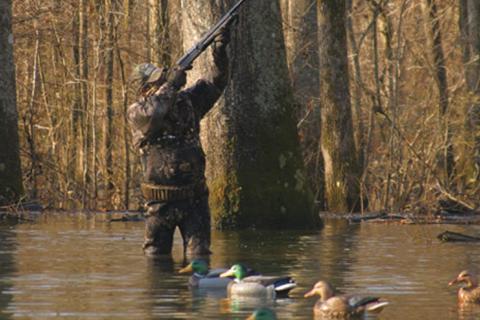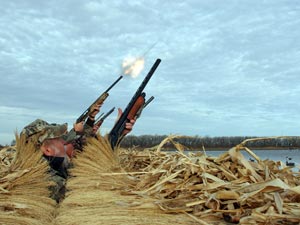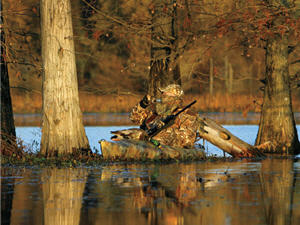
It was one of the best shooting performances on ducks that I'd ever seen, and from one of the most unlikely shooters.
It was Youth Waterfowl Day in Tennessee. Thirteen-year-old Rob Clouser was in a hunt club blind with two other young friends and three adult chaperones, including me. We'd just gotten situated and told the boys to load up. Their excitement was electric. Legal shooting hours were already in, and ducks were flying.
 |
| Several factors come into play in being a good waterfowl shot, and an important one is patience. |
"Here come a couple," Rob said eagerly. I looked out and spotted two mallard drakes passing over the decoys at 45 yards, a challenge even for veteran adult wingshots. But this was youth day, and Rob was anxious to burn some powder. What the heck?
"Give'em a try," I said smugly.
![]() Tip: Duck Hunting Success in Any Weather
Tip: Duck Hunting Success in Any Weather
Rob rose from his shooting hole, swung on the first duck and fired, and it dropped like a stone. Then he pulled off to the second mallard and fired again, and it tumbled behind the first duck. Unbelievable!
"Great shooting," I said to Rob, who shrugged like, "Well, wasn't that what I was supposed to do?"
Some shooters — like my young friend — are naturals. They are gifted athletes with great hand/eye coordination. They swing a shotgun like a golf pro does a driver or a major league baseball player a bat.
For most, however, hitting ducks is ever more difficult and frustrating. Many hunters routinely shoot at least a box of shells to bag a limit. For them, there's nothing easy about mounting a shotgun, holding the proper lead, and downing a flying target.
Consistently bagging ducks with a shotgun is a learned skill like any other athletic endeavor. Natural talent certainly helps, but shooters with mediocre ability can still develop deadly shooting proficiency. Doing so requires good preparation, qualified instruction and more than a little practice. In other words, it takes a structured plan for improvement, and those who devise and implement such a plan will get better.
Following is a list of 10 tips for bagging more ducks with fewer shots. No question, hunters who follow these guidelines will see their shooting average on these birds go up.
1. Use a Shotgun That Fits
Many hunters never know the advantage — or the joy — of shooting a fitted shotgun. They buy a gun off the shelf and take it to the field without regard for such measurements as pull length, drop at comb, pitch and other variables that affect how the gun matches the shooter's physical measurements. A shotgun that's a poor fit will be harder to swing and hold on target than one that's customized to personal dimensions.
So, when buying a new shotgun, go to a gunsmith who can help you get the right fit. Or, if you already have a waterfowl gun you like, take it to the gunsmith and let him adjust the stock so it'll snug into your shoulder like a long-time dance partner. (When getting this fitting, be sure to wear bulky outer clothes you'll have on while hunting.)
2. Test Your Shotgun's Pattern With Various Loads and Choke Combinations
Set up a pattern board, cover it with white paper, and trace a life-size duck/goose image in the center. Move back 40 yards, then shoot directly at the image with your shotgun stabilized in a shooting rest. Try different chokes and shotshell loads to see how various combinations perform. (Be sure to check manufacturer's recommendations on which chokes to use with steel-shot loads.) Patterning does three things. It shows which combination of choke and load provides the best performance. It helps the shooter visualize how big a duck or goose is at 40 yards. And it builds confidence that the shotgun can do its job if the shooter does his.
![]() Tip: Patterning Your Shotgun for Ducks
Tip: Patterning Your Shotgun for Ducks
3. Head to the Skeet Range, and Engage an Instructor to Offer Shooting Advice
Skeet shooting offers great practice for the type of shots waterfowl hunters encounter (crossing, incoming, etc.). Hire a shooting instructor for a lesson, or ask a veteran skeet shooter to help you. Start on a less challenging station, and shoot it repeatedly until you learn the sight picture (muzzle location relative to the movement of the target) to break clays consistently. Also, follow your instructor's advice on how to mount your shotgun, how much lead to hold, following through, etc. Then, after this first instructional session, return to the range as often as possible for more practice. The more you shoot, the more comfortable you'll become with your shotgun and the more effective you'll be at downing passing ducks.
4. Don't Rush Your Shots
One of the biggest mistakes inexperienced waterfowl hunters make is shooting too fast. There's no reason to rush. Instead, make a deliberate effort to slow down when mounting your gun, tracking your target and squeezing the trigger at just the right moment.
 |
| Having a shotgun that fits, focusing on a single target, being patient in waiting for good shots and other factors come into play in increasing your percentage of hits versus misses. |
5. Focus on Your Target Bird's Eye
Another mistake many beginners make is shooting at the whole bird, which can lead to drawing tailfeathers instead of making a lethal shot. To correct this, consciously focus on the bird's eye, and use this as your aiming point. This helps in two ways. One, if you can't see the eye, the bird is too far away; don't shoot! And two, if you can see the eye, keep your attention fixed on it, which will help you swing your shotgun ahead of the bird instead of behind it.
6. Don't Try to Compute Lead
True, you must hold the correct amount of lead to hit a flying bird. However, the combination of variables is infinite (distance of bird, direction of flight, angle of flight, speed of flight, etc.). There is no way to consciously analyze each situation and figure the right amount of lead.
But fortunately, you don't have to! Shooters have a built-in calculator that will instinctively determine how much lead is needed. A shooter should simply follow the target and use the shotgun barrel as an extension of his line of sight. If he has a proper gun mount, "stays on the bird" and doesn't stop moving the gun barrel when he shoots, holding the right lead will come naturally.
7. On Long Passing Shots, Hold More Lead Than You Think is Necessary
The "don't calculate lead" rule works better when ducks are close. However, when a bird is crossing at 40 yards or longer, hold more lead than you think you need to. At this range, it's difficult to hold too much lead. Most misses are behind the bird. So get way out in front, keep the shotgun barrel swinging, and pull the trigger. Trial-and-error testing will give you the proper sight picture for accuracy at these long ranges.
8. Shoot at One Bird at a Time
Too many beginners get excited and shoot into the flock at large instead of focusing aim on a single duck. There's a lot of empty airspace in an incoming flight of ducks. Be intentional about aiming and shooting at one bird only. Then if it drops, you may acquire another target and try for a double. But remember that a double starts by hitting the first bird you shoot at.
9. When a Duck is Coming Straight in, Aim, Blot it Out and Fire
Many beginning shooters are intimidated by a head-on shot, but actually this is one of the easiest in the book. Aim slightly below the bird, raise the gun up into its flight path, and pull the trigger when the gun barrel blots out the bird. Or, if the duck is descending to land, aim at its feet and shoot. By the time the shot charge gets on target, the duck will have dropped into the middle of the pattern.
10. Use a Quality Non-Toxic Load
Steel-shot loads are greatly improved over initial loads that hit the market when lead shot was banned. Today's premium steel loads are fast and carry plenty knockdown power to bag ducks cleanly to 40 yards. (Number 2 steel shot is a good choice for shooting ducks over decoys.) Beyond this range, however, steel loses its punch quickly. Better alternatives for long-range ducks are loads containing alloy-shot of tungsten, bismuth, iron and other non-toxic metals. These loads provide performance equal to or surpassing lead-shot loads. However, they are very expensive and impractical for budget-minded hunters who shoot ducks frequently.
Here's the bottom line on becoming a better duck shot. Improvement won't just happen magically. Again, it will come in direct response to an effort on the shooter's behalf to improve his skill level. This is one undertaking where preparation and training far outweigh luck in determining success.
My young friend Rob Clouser was certainly lucky when he doubled on those two mallards, now a half-dozen years ago. But more, he had benefited from his dad's expert shooting instruction and the opportunity to spend many days in the blind. The same will hold true for other shooters.
And by the way, today Rob is a strapping college student, and he's also still poison on any ducks that fly reasonably close. When he shoulders his shotgun, his confidence soars, and birds off the end of his muzzle are likely to drop!
- 73992 views

